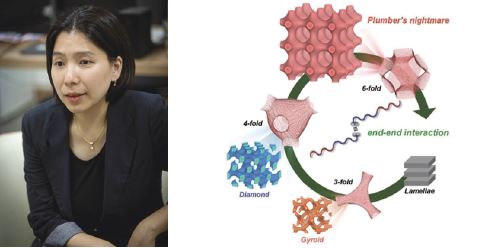
The “plumber’s nightmare” structure, which appears to trap all exits inward, has been a challenge for implementation due to its complexity. However, a recent breakthrough at POSTECH has turned this seemingly impossible concept into reality. Published in Science, the study presents the successful realization of complex nanostructures using block copolymers (BCPs).
BCPs, composed of blocks of different polymers, exhibit the unique ability to self-assemble into a variety of nanostructures, each endowed with a diverse range of properties. Despite active research focused on the optical and mechanical characteristics of BCPs, challenges emerge due to the thermodynamic instability inherent in complex nanostructures. A research team led by Professor Moon Jeong Park (CE) and integrated Ph.D. student Ho Jun Lee has characterized the “plumber’s nightmare” structure, which was purely theoretical, by focusing on the overlooked 1% of polymer chain ends. Through the synthesis of di-end-functionalized BCP, they successfully realized the envisioned structure, anticipated to exhibit exceptional optical and mechanical properties.
Not only did the team implement the structure but also succeeded in producing various BCP structures like gyroids and diamonds that had remained mysterious until now. The significance of the study lies in demonstrating that, even with diverse adjustments to BCP polymer composition and main chain chemical properties, stable implementation of complex structures is achievable when strong forces exist at the chain ends.
This research holds promise for future development in the field of complex polymer nanostructures, demonstrating universality and versatility applicable to a variety of composite structure developments. Alisyn J. Nedoma, a professor in the Department of Chemical and Biological Engineering at the University of Sheffield stated, BCP enables more efficient creation of nanostructures resulting in cost savings in the process. Prof. Park expressed expectations that this research would establish a method for developing tailored network structures in polymer BCP, serving as a platform for diverse BCP developments in the nano-technology application field.
This research was supported by the National Research Foundation of Korea (NRF) funded by the Ministry of Science and ICT.


